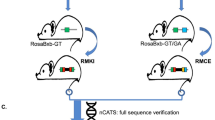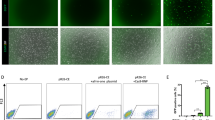Abstract
Introducing human genes into mice offers the opportunity to analyze their in vivo function or to obtain therapeutic molecules. For proper gene regulation, or in case of multigene families, megabase (Mb)-sized DNA fragments often have to be used. Yeast artificial chromosome (YAC)–mediated transgenesis is irreplaceable for this purpose, because alternative methods such as the use of bacterial artificial chromosomes (BACs) cannot introduce DNA fragments larger than 500 kb into the mouse germ line. However, YAC libraries often contain only partial gene loci. Time-consuming reconstruction of YACs, genetic instability and the difficulty in obtaining intact YAC DNA above a certain size impede the generation of humanized mice. Here we describe how to reconstruct YACs containing Mb-sized human DNA, such as the T cell receptor-α (TRA) gene locus, thus facilitating the introduction of large DNA fragments into the mouse germ line. Fusion of YAC-containing yeast and embryonic stem (ES) cells avoids the need for YAC DNA purification. These ES cells are then used to stably introduce the functional TRA gene locus into the mouse germ line. The protocol takes ∼1 year to complete, from reconstruction of the entire TRA gene locus from YACs containing partial but overlapping TRA regions to germline transmission of the YAC.
This is a preview of subscription content, access via your institution
Access options
Subscribe to this journal
Receive 12 print issues and online access
$259.00 per year
only $21.58 per issue
Buy this article
- Purchase on Springer Link
- Instant access to full article PDF
Prices may be subject to local taxes which are calculated during checkout






Similar content being viewed by others
References
International Human Genome Sequencing Consortium. Initial sequencing and analysis of the human genome. Nature 409, 860–921 (2001).
Lee, S.T. et al. Altered microRNA regulation in Huntington's disease models. Exp. Neurol. 227, 172–179 (2011).
Kleinjan, D.A. et al. Long-range downstream enhancers are essential for Pax6 expression. Dev. Biol. 299, 563–581 (2006).
Navas, P.A., Li, Q., Peterson, K.R. & Stamatoyannopoulos, G. Investigations of a human embryonic globin gene silencing element using YAC transgenic mice. Exp. Biol. Med. (Maywood) 231, 328–334 (2006).
Li, L.P. et al. Transgenic mice with a diverse human T cell antigen receptor repertoire. Nat. Med. 16, 1029–1034 (2010).
Pruzina, S. et al. Human monoclonal antibodies to HIV-1 gp140 from mice bearing YAC-based human immunoglobulin transloci. Protein Eng. Des. Sel. 24, 791–799 (2011).
Han, S.J., O'Malley, B.W. & DeMayo, F.J. An estrogen receptor-α activity indicator model in mice. Genesis 47, 815–824 (2009).
Harju-Baker, S., Costa, F.C., Fedosyuk, H., Neades, R. & Peterson, K.R. Silencing of Aγ-globin gene expression during adult definitive erythropoiesis mediated by GATA-1-FOG-1-Mi2 complex binding at the -566 GATA site. Mol. Cell Biol. 28, 3101–3113 (2008).
Bentley, K.L., Shashikant, C.S., Wang, W., Ruddle, N.H. & Ruddle, F.H. A yeast-based recombinogenic targeting toolset for transgenic analysis of human disease genes. Ann. N Y Acad. Sci. 1207 (suppl. 1): E58–E68 (2010).
Dow, L.E. & Lowe, S.W. Life in the fast lane: mammalian disease models in the genomics era. Cell 148, 1099–1109 (2012).
Seo, H. & Isacson, O. The hAPP-YAC transgenic model has elevated UPS activity in the frontal cortex similar to Alzheimer's disease and Down's syndrome. J. Neurochem. 114, 1819–1826 (2010).
t Hoen, P.A. et al. Generation and characterization of transgenic mice with the full-length human DMD gene. J. Biol. Chem. 283, 5899–5907 (2008).
Mendez, M.J. et al. Functional transplant of megabase human immunoglobulin loci recapitulates human antibody response in mice. Nat. Genet. 15, 146–156 (1997).
Xu, Z., Lefevre, G.M. & Felsenfeld, G. Chromatin structure, epigenetic mechanisms and long-range interactions in the human insulin locus. Diabetes Obes. Metab. 14, 1–11 (2012).
O'Connor, M., Peifer, M. & Bender, W. Construction of large DNA segments in Escherichia coli. Science 244, 1307–1312 (1989).
Ioannou, P.A. et al. A new bacteriophage P1-derived vector for the propagation of large human DNA fragments. Nat. Genet. 6, 84–89 (1994).
Burke, D.T., Carle, G.F. & Olson, M.V. Cloning of large segments of exogenous DNA into yeast by means of artificial chromosome vectors. Science 236, 806–812 (1987).
Peterson, K.R. Transgenic mice carrying yeast artificial chromosomes. Expert Rev. Mol. Med. 5, 1–25 (2003).
Scherer, S. & Davis, R.W. Replacement of chromosome segments with altered DNA sequences constructed in vitro. Proc. Natl. Acad. Sci. USA 76, 4951–4955 (1979).
Duff, K. & Huxley, C. Targeting mutations to YACs by homologous recombination. Methods Mol. Biol. 54, 187–198 (1996).
Silverman, G.A. Reconstruction of large genomic segments of DNA by meiotic recombination between YACs. Methods Mol. Biol. 54, 199–216 (1996).
McKee-Johnson, J.W. & Reeves, R.H. Fragmentation and integrative modification of YACs. Methods Mol. Biol. 54, 167–186 (1996).
Kohno, K. et al. Stability of YACs containing ribosomal or RCP/GCP locus DNA in wild-type S. cerevisiae and RAD mutant strains. DNA Res. 1, 191–199 (1994).
Korenberg, J.R. & Rykowski, M.C. Human genome organization: Alu, LINES, and the molecular structure of metaphase chromosome bands. Cell 53, 391–400 (1988).
Moir, D.T. et al. Rapid identification of overlapping YACs in the MEN2 region of human chromosome 10 by hybridization with Alu element–mediated PCR products. Gene 136, 177–183 (1993).
Schedl, A. et al. Transgenic mice generated by pronuclear injection of a yeast artificial chromosome. Nucleic Acids Res. 20, 3073–3077 (1992).
Strauss, W.M. et al. Germline transmission of a yeast artificial chromosome spanning the murine alpha 1(I) collagen locus. Science 259, 1904–1907 (1993).
Jakobovits, A. et al. Germ-line transmission and expression of a human-derived yeast artificial chromosome. Nature 362, 255–258 (1993).
Moreira, P.N. et al. Efficient generation of transgenic mice with intact yeast artificial chromosomes by intracytoplasmic sperm injection. Biol. Reprod. 71, 1943–1947 (2004).
Huxley, C. Exploring gene function: use of yeast artificial chromosome transgenesis. Methods 14, 199–210 (1998).
Noskov, V.N. et al. Isolation of circular yeast artificial chromosomes for synthetic biology and functional genomics studies. Nat. Protoc. 6, 89–96 (2011).
Peterson, K.R. Preparation of intact yeast artificial chromosome DNA for transgenesis of mice. Nat. Protoc. 2, 3009–3015 (2007).
Moreira, P.N. et al. Improving the generation of genomic-type transgenic mice by ICSI. Transgenic Res. 16, 163–168 (2007).
Davies, N.P. & Huxley, C. YAC transfer into mammalian cells by cell fusion. Methods Mol. Biol. 54, 281–292 (1996).
Alami, R. et al. β-globin YAC transgenes exhibit uniform expression levels but position effect variegation in mice. Hum. Mol. Genet. 9, 631–636 (2000).
Kouprina, N. & Larionov, V. Selective isolation of genomic loci from complex genomes by transformation-associated recombination cloning in the yeast Saccharomyces cerevisiae. Nat. Protoc. 3, 371–377 (2008).
Rack, K.A. et al. A chromosome 14q11/TCR α/δ specific yeast artificial chromosome improves the detection rate and characterization of chromosome abnormalities in T-lymphoproliferative disorders. Blood 90, 1233–1240 (1997).
Wei, S. & Concannon, P. Repertoire and organization of human T cell receptor–α region variable genes. Genomics 38, 442–445 (1996).
Sambrook, J. & Russell, D.W. Analyzing yeast colonies by PCR. Cold Spring Harb. Protoc. http://dx.doi.org/10.1101/pdb.prot4015 (2006).
Valdes, J.M., Tagle, D.A. & Collins, F.S. Island rescue PCR: a rapid and efficient method for isolating transcribed sequences from yeast artificial chromosomes and cosmids. Proc. Natl. Acad. Sci. USA 91, 5377–5381 (1994).
Bates, G. Isolation of YAC ends by plasmid rescue. Methods Mol. Biol. 54, 139–144 (1996).
Lewis, B.C., Shah, N.P., Braun, B.S. & Denny, C.T. Creation of a yeast artificial chromosome fragmentation vector based on lysine-2. Genet. Anal. Tech. Appl. 9, 86–90 (1992).
Spencer, F. & Simchen, G. Transfer of YAC clones to new yeast hosts. Methods Mol. Biol. 54, 239–252 (1996).
Hermanson, G.G., Hoekstra, M.F., McElligott, D.L. & Evans, G.A. Rescue of end fragments of yeast artificial chromosomes by homologous recombination in yeast. Nucleic Acids Res. 19, 4943–4948 (1991).
Ragoussis, J., Trowsdale, J. & Markie, D. Mitotic recombination of yeast artificial chromosomes. Nucleic Acids Res. 20, 3135–3138 (1992).
Fairhead, C., Heard, E., Arnaud, D., Avner, P. & Dujon, B. Insertion of unique sites into YAC arms for rapid physical analysis following YAC transfer into mammalian cells. Nucleic Acids Res 23, 4011–4012 (1995).
Pavan, W.J., Hieter, P. & Reeves, R.H. Modification and transfer into an embryonal carcinoma cell line of a 360-kilobase human-derived yeast artificial chromosome. Mol. Cell Biol. 10, 4163–4169 (1990).
Bryja, V., Bonilla, S. & Arenas, E. Derivation of mouse embryonic stem cells. Nat. Protoc. 1, 2082 (2006).
Gibson, D.G. et al. Creation of a bacterial cell controlled by a chemically synthesized genome. Science 329, 52–56 (2010).
Dymond, J.S. et al. Synthetic chromosome arms function in yeast and generate phenotypic diversity by design. Nature 477, 471–476 (2011).
Acknowledgements
We thank M. Textor for technical assistance, and G. Willimsky, T. Kammertoens, D. Strathdee and J. Guo for critical reading of the manuscript. We thank E. A. Macintyre (Hôpital Necker Enfants Malades) for YAC 27BE8 (y27BE8), isolated from the ICRF human YAC library. We also thank A. Garratt (Max Delbrük Center) for the ES14.1 cell line. This work was supported by grants from the Deutsche Forschungsgemeinschaft (Sonderforschungsbereich TR36) and the 'Alliance' program of the Helmholtz-Gemeinschaft Deutscher Forschungszentren (HA-202).
Author information
Authors and Affiliations
Contributions
L.L. designed the protocol, performed the experiments, analyzed the data and wrote the manuscript. T.B. supervised the project, analyzed the data and wrote the manuscript.
Corresponding author
Ethics declarations
Competing interests
The authors declare no competing financial interests.
Rights and permissions
About this article
Cite this article
Li, L., Blankenstein, T. Generation of transgenic mice with megabase-sized human yeast artificial chromosomes by yeast spheroplast–embryonic stem cell fusion. Nat Protoc 8, 1567–1582 (2013). https://doi.org/10.1038/nprot.2013.093
Published:
Issue Date:
DOI: https://doi.org/10.1038/nprot.2013.093
This article is cited by
-
A supernumerary synthetic chromosome in Komagataella phaffii as a repository for extraneous genetic material
Microbial Cell Factories (2023)
-
Beyond editing to writing large genomes
Nature Reviews Genetics (2017)
-
Hydrogel-derived non-precious electrocatalysts for efficient oxygen reduction
Scientific Reports (2015)
-
Design of a functional cyclic HSV1-TK reporter and its application to PET imaging of apoptosis
Nature Protocols (2015)
-
Transferring whole genomes from bacteria to yeast spheroplasts using entire bacterial cells to reduce DNA shearing
Nature Protocols (2014)
Comments
By submitting a comment you agree to abide by our Terms and Community Guidelines. If you find something abusive or that does not comply with our terms or guidelines please flag it as inappropriate.



